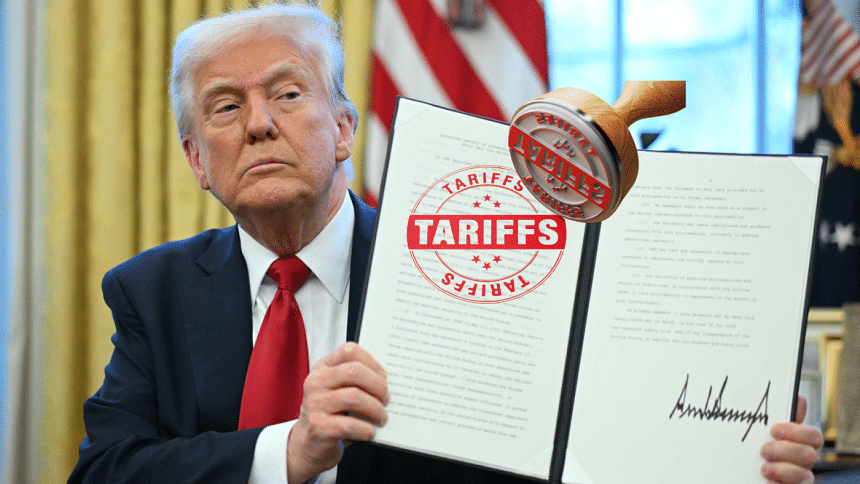How fair are Trump’s reciprocal tariffs?

The reciprocal tariffs introduced by US President Donald Trump are largely unilateral, as they were not discussed or agreed upon through any multilateral platform involving other nations.
In trade negotiations, Trump pushed partner countries to accept deals on his terms, leveraging the US's position as a global economic powerhouse. His approach involved imposing tariffs on imports from other countries without offering equivalent concessions.
In essence, many countries have granted zero-duty access to US goods, while the US has not reciprocated. Exporters from these countries face significant tariffs when shipping goods to the US, but American exporters enjoy duty-free access in return, which is a clearly one-sided arrangement.
Take the case of Bangladesh. While Bangladesh provides duty-free access to many American goods, the US continues to impose tariffs on Bangladeshi exports to the American market. The same is true for several other countries that offer zero-duty privileges to US exports.
Trump's tariff policy undermines the global trade rules governed by the World Trade Organization (WTO). He imposed the tariffs unilaterally, without adhering to any of the WTO's established frameworks, developed over decades to promote fair distribution of global wealth through trade.
If tariffs are imposed unilaterally, one must ask: What purpose does the WTO serve? Before Trump's reciprocal tariffs, the average US tariff rate was just over 2 percent, making it one of the most open markets in the world. With his measures, the average tariff rate rose to nearly 15 percent, bringing it closer to the global average.
Why is Trump imposing these tariffs?
Within his first few months in office, Trump made two significant decisions.
First, he suspended the major operations of USAID, the US government's aid agency that disburses around $64 billion annually globally, particularly to support health, research, and food aid for low-income populations. Trump halted much of this aid, arguing that he believed in "trade, not aid."
But instead of going for a free flow of trade, he introduced what he terms 'reciprocal tariffs' and invited partner countries to tariff negotiations. These moves align with his campaign slogan, Make America Great Again (MAGA), which included reviving the manufacturing sector and creating domestic jobs.
A major target was China. Trump imposed tariffs as high as 145 percent on Chinese goods to curb the country's growing economic influence.
He did not stop there. He appears to have targeted nations that relied heavily on Chinese raw materials. For example, his administration announced a 35 percent tariff on Bangladesh's goods, which, according to industry insiders, is largely because of its dependence on Chinese inputs in sectors like garments.
Trump sought to bring key industries, such as semiconductors and microchips, back to the US, where China currently dominates the market. He declared foreign trade practices a "national emergency" and invoked the International Emergency Economic Powers Act of 1977 (IEEPA) to justify his actions.
According to an April 2 statement by the White House, "Large and persistent annual US goods trade deficits have led to the hollowing out of our manufacturing base; resulted in a lack of incentive to increase advanced domestic manufacturing capacity; undermined critical supply chains; and rendered our defence-industrial base dependent on foreign adversaries."
The statement added that Trump was acting to address the national emergency created by "the absence of reciprocity in our trade relationships and other harmful policies like currency manipulation and exorbitant value-added taxes (VAT) perpetuated by other countries."
Is it sustainable?
However, many experts argue that this "Made-for-America" reciprocal tariff system is unsustainable. Reports suggest it was developed by three key figures in Trump's circle: Scott Kenneth Homer Bessent, the treasury secretary and former hedge fund manager; Howard William Lutnick, secretary of commerce and a businessman; and Peter Kent Navarro, economist and trade adviser to Trump.
Critics note that although the US aims to revive its manufacturing sector, it may not have the necessary labour force to support such an industrial shift.
For instance, setting up labour-intensive industries like garment factories in the US is challenging, as they require large numbers of low-paid workers, something not feasible in the American context.
Trump also targeted China's dominance in semiconductors and microchips, but establishing such factories requires highly specialised expertise that cannot be built overnight.
Ultimately, this uneven tariff policy may backfire. Higher import costs could reduce trade volumes, push up consumer prices, and fuel inflation in the US. In the long run, these tariffs may prove neither sustainable nor just.

 For all latest news, follow The Daily Star's Google News channel.
For all latest news, follow The Daily Star's Google News channel. 



Comments